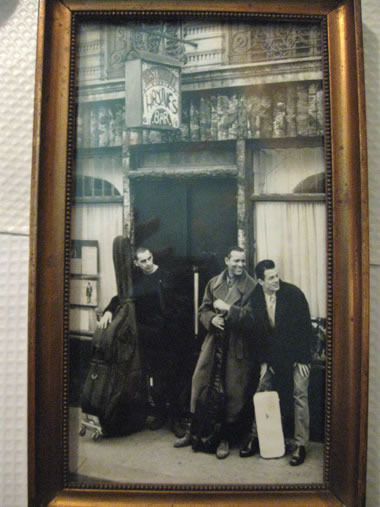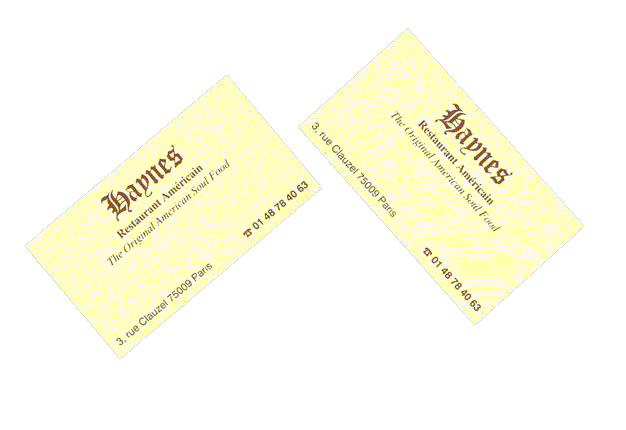GI IN EUROPE
Abroad war mutters and on December 7th, 1941, Pearl Harbour precipitates America into general fire. At the age of 28, Leroy joins the Pacific Army from 1942 to 1945. Then in 1946, he becomes Warrant Officer Junior and moves to serve in Germany till 1949, more exactly on the bases of Kitzingen and Würzburg in Bavaria. His reputation as a footballer followed him and he trains GI teams there.
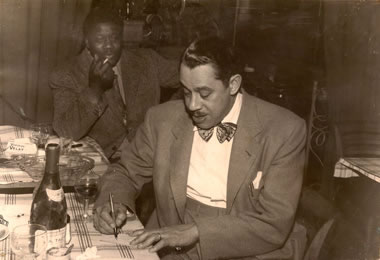
Leroy Haynes with Cab Calloway, at "Gabby & Haynes"
Fate or his will, Leroy does not continue his military career and prefers to return to civil life. He travels in Europe and discovers France with which he falls in love. He has then the idea to register in Sorbonne to prepare a Doctorate of Sociology. But, either due to his lack of French, or his lack of money, or to both, his university ambitions will stay only at the state of project. Settled in Paris, he completes his GI’s paid by working as a barman in a French traditional restaurant. It is in these circumstances that he meets Gabrielle Lecarbonnier, nick name Gabby, a young Frenchwoman born the July 5, 1928, from Cherbourg, whom he marries very rapidly.
In 1949, with 900 dollars in hand, they started a restaurant in a tiny place located rue Manuel, 7, in the 9th district, near rue des Martyrs and close to Place Pigalle. "Gabby and Haynes", that’s the restaurant’s name, is the first table in France offering traditional old American South cooking.
AMERICA'S LITTLE ACRE IN PARIS
We can imagine how hard it was at the beginning : " all I knew how to cook, was green vegetables, chicken, chitterlings and soul food, a kind of food French people could not understand " tells Leroy to a journalist. He said that one early morning, while he came back from the meat market (at the time in Les Halles in Paris), he came back rue Manuel with two military trucks full of black GI’s coming from Nuremberg and lost in Paris.
" They really found in my place the food their mother used to make : fatback and greens, piece-fried sausage, etc. ". The information is then going to spread in the American bases of NATO : it’s possible to find Southern cooking in Pigalle.
The black GI’s are soon joined by American jazzmen, more and more numerous in the 1950 to perform in Paris, such as Louis Armstrong, Count Basie, Cab Calloway, Sydney Bechet (godfather of his son Richard), The Platters or Lionel Hampton. Gabby and Haynes becomes a small part of Mississippi for all these nostalgic blacks of their classic and so tasty" food soul ".
Leroy tells that Louis Armstrong, during a concert, hurried up to finish his last song announcing to the public that a warm plate of "red beans and rice" was waiting for him at Haynes.
The restaurant quickly becomes a place of preference for writers and afro-American jazz musicians visiting or living in Paris during these post-war years. Richard Wright (1908-1960), a writer born in Louisiana, author of Native Son and Black Boy, living in Paris and welcomed by Sartre and the group of Les Temps Modernes, has his customs there ; as well as James Baldwin, another regular customer.
According to New York Time’s figure, approximately 2000 to 3000 black American live in Paris during the 50s : students, artists, writers, showmen, and hotel’s or service’s employees, American Embassy and Consulate employees, NATO’ s employees who’s headquarter is Porte Dauphine or UN’s employees. Some took the French nationality and many married Europeans.
A FORMER BROTHEL BECOMES THE TEMPLE OF SOUL FOOD
In ten years France was transformed, especially due to the Marshall Plan. North of the 9th district in Paris knows in the evening an effervescent life : music halls, cinemas, cabarets, strip teases. Night birds, musicians, tourists and neighbours are looking for pleasure and relaxing places away from boulevard’s jumble between Blanche and Pigalle, familiar or exotic places to eat a piece and if possible hear some live music.
Some good tables stay open late to welcome these guests not in a hurry to go to sleep. On the 18th side there are Abbesses and rue Lepic’s restaurants which leads towards Montmartre, today so frequented, but relatively deserted in the years 1950-60. On the 9th side there are discreet restaurants as Corossol Doudou at the end of rue Laferrière (behind the place Saint Georges), a Caribbean tavern where one can eat hot boudin and cod acras. La Cloche d’or in the angle of rue Mansart and rue Fontaine, a kind of Swiss chalet with a big fireplace and its dining rooms on the top floor.
Down on the street, rue Manuel, it is now written Chez Gabby's on the banner of the restaurant created in 1949 ; the couple got separated in 1960. Meanwhile Leroy and Gabby had a little boy, Richard who later will learn to cook as his father.
What happened to Leroy? It is a period badly known in his life: after he separated from Gabby he moved to Germany, in particular to Frankfurt, where he stays until 1964. It is only when he returns in Paris, that he came back in the 9th, and opens a second restaurant : Chez Haynes, rue Clauzel, in front of a street coal trader. It is a street which also looks onto rue des Martyrs, but located on the other pavement, 50 m above rue Manuel.
The number 3 of rue Clauzel is, according to the legend, a former brothel frequented in the XIXth century and at the beginning of the XXth by artists and middle-class people who live in the district. In Van Gogh, Maurice Pialat’s movie (1991), a hint is made concerning a brothel rue Clauzel where the painter had his customs. We know that the painter used to buy his brushes and his tubes at Le Père Tanguy (from 1873 to 1892) situated number 14 on the opposite pavement, the place was affectionately named by its customers "Le Socrate de la rue Clauzel ". Did Vincent van Gogh really haunt these places? It is not impossible. Other significative reference, Guy de Maupassant, author among others of La Maison Tellier, lived in 17 rue Clauzel. The rue Clauzel, quite as rue Manuel (formerly rue de Morée) are described by Paul Léautaud in its narrative Le petit ami (Mercure de France, 1903) as a places of soliciting :" women in hair which hung up the passers-by ". This small part of the 9th - " Breda Street de Gavarni (…) full of artists and “lorettes " - was indeed one of the warm districts of Paris before 14-18 War. On 3 rue Clauzel, arches and still present twisted columns would be the work of a decorator or an interior designer answering the necessity of fantasy linked to this pleasure place.
Leroy must be amused that so much faribolles were able to occur between these walls. Chez Haynes open finally its doors : strange place with its wooden logs facade, a " Hut in Canada " in Pigalle. On the menu, tuna salad, spare ribs barbecue wipe, honey fried chicken, Mexican Chile, shrimp and chicken gumbos, T bone steak, grilled gambas and kidney beans. And as desserts, banana and carrot cake, famous apple pie or banana split.
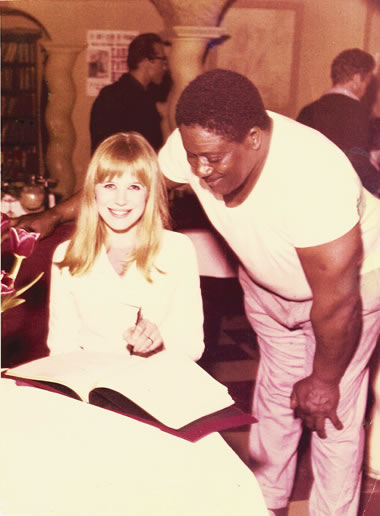
Marianne Faithfull and Leroy Haynes, Paris, in the mid 60ies in the restaurant of the rue Clauzel
Many music and movie stars will stop here: Ray Charles, Elizabeth Taylor, Richard Burton, Peter O' Toole, Rod Steiger, Warren Beatty, Sidney Poitier, Marianne Faithfull and many more artists and musicians of that time, signing the Visitors' book and letting the photographers immortalize their presence. Another politic celebrity, The Black Panther Stokely Carmichael also came to rue Clauzel.
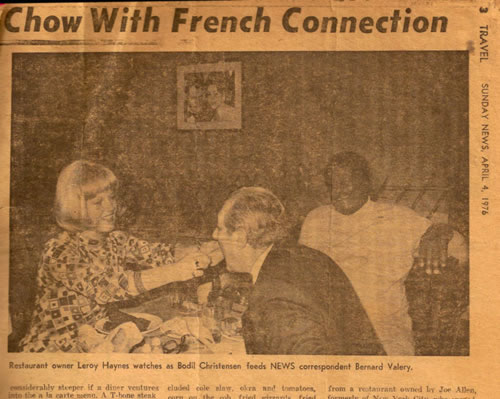
Bodil Christensen, manager and the muse of the restaurant the rue Clauzel, with periodist Bernard Valery, correspondent for the Sunday News and her boss Leroy Haynes.
Excerpt of Sunday New, april 4, 1976
During 1970s, the room service management is given to Bodil Christensen, a tall pleasant Danish who will make the house works with energy. Especially that Haynes is not any more the only American restaurant in Paris.
Most are going to open in the district of Les Halles, then in full transformation at the time of the vast construction site which will destroy the classic arts Baltard pavilions to benefit the conceited and stupid Forum. Joe Allen, famous for his New York style and his squared printed tablecloths, on rue Pierre Lescot, is created in 1972.
Not far from there, Conway, rue Saint Denis with its big wooden lounge, opens in 1976. There is also the nice Mother's Earth, rue des Lombards with its old sofas, wooden chairs and tables bought in thrift shops, not far from the records store Open Market which drains a whole group of rock and rythm'n’blues music lovers.
For the purists, Gabby who still officiates rue Manuel with Richard Haynes as the cook, and Chez Haynes of course with Leroy, always remain inescapable references.
IN MY ARMS NOUNOU !!
Leroy Haynes knows another glory, more modest, as a movie actor and extra. We discover its massive silhouette in films as Un nommé la Rocca from Jean Becker (1961), Le Gendarme à New York (1965), Trois chambres à Manhattan (1965), Tendre voyou (1966), Mr Freedom from William Klein (1969), Popsy Pop from Jean Herman (1970) or Les Pétroleuses (1971). He sometimes receives his friends and colleagues in a warm and jazzy atmosphere. Evenings concerts are often going to take place in this Blue Note’s appendix, a jazz box rue Artois, in the 8th, managed by Ben Benjamin.
In the evening of the openning of Les Pétroleuses, both stars Brigitte Bardot and Claudia Cardinale, accompanied with their director Christian-Jaque landed rue Clauzel. " In my arms Nnounou ! " shouted BB to Haynes, her partner in the movie.
After Leroy died in April 1986, Chez Haynes will continue to live during almost twenty-three years thanks to the will and to Maria Dos Santos's courage, a Portuguese living in Paris, which he marries on April 1st, 1985. To give some new breath to the old house, Maria organizes Brazilian early evening dances on Sunday afternoon.
Today, Maria is turnings the last page of what still remains the Pigalle’s soul of the 50s and 60s.
Jean SEGURA
LIRE EGALEMENT :
GABBY OH GABBY ! DANS L'OMBRE DE LEROY HAYNES
Une histoire du restaurant de la rue Manuel (French only)


